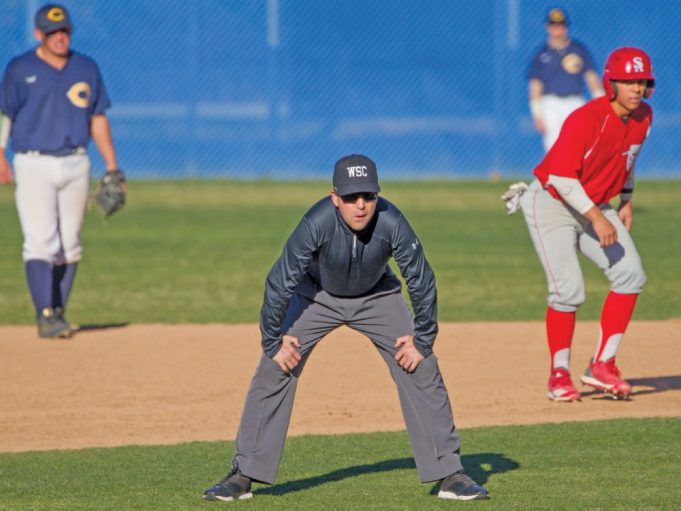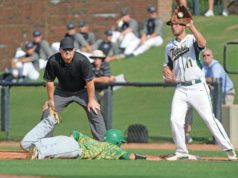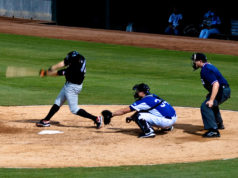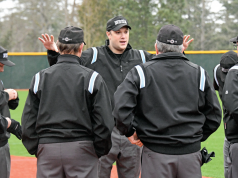Know What Is, And Is Not, Umpire Interference
F
or many umpires, their definition of a job well done includes being able to walk off the field without anyone really noticing they were out there in the first place.
And if notice is going to come, every umpire wants it to be for handling a situation correctly and efficiently, such as nailing a bang-bang play at first and having it confirmed by replay, or applying a misunderstood rule properly in the heat of the moment.
What umpires hope to avoid is becoming “part of the game.” However, when you mix baseballs traveling at high rates of speed and umpires working in close proximity to players around home plate, every once in a while there is no avoiding the unavoidable. Like it or not, sometimes umpires are going to become part of the action.
As such, it is important for umpires to understand what is and is not “umpire interference” according to the NFHS, NCAA and professional rule codes, because not every instance of an umpire becoming part of a play fits that description.
Play 1: With no runners on base, B1 hits the ball sharply down the first-base line. After making contact with the ground in fair territory, and passsing the first baseman, the ball hits U1 and (a) caroms into the outfield, or (b) falls at the umpire’s feet, where he picks it up. In (a), B1 safely advances to third base on the play, after which the defensive coach comes out to argue U1 interfered on the play. In (b), B1 has yet to reach first base at the time the umpire handles the baseball. Ruling 1: In (a), this is not umpire interference and the ball remains live and in play. The rules in all three codes specifically address in order for a fair batted ball that hits an umpire to become dead, it must touch an umpire before touching any fielder and before passing any fielder other than the pitcher (NFHS 5-1-1f-1; NCAA 6-1c, 6-1h, 6-2f, 6-2f Note; pro 5.05b4, 5.06c6). In (b), in NFHS, the ball becomes dead as soon as the umpire handles a live ball (5-1-1h) and B1 would be awarded first base (8-2-9). In NCAA and pro, there are no provisions for a live ball becoming dead if handled by an umpire, except when an umpire wishes to examine the ball (NCAA 6-5g).
Play 2: With a runner on (a) first base, or (b) second base, B2 hits a ground ball sharply up the middle. After the ball has passed the pitcher, but before it has been touched by or passed any infielder, it strikes U2 in the leg. Ruling 2: The ball immediately becomes dead in both situations (NFHS 5-1-1f-1; NCAA 6-2f; pro 5.06c6) and the batter is awarded first base and credited with a single (NFHS 8-1-2b; NCAA 6-2f Pen.; pro 5.05b4). In (a), because R1 is forced to advance, he is awarded second base. In (b), because R2 is not forced to advance, he is returned to second base (NFHS 8-3-1b; NCAA 6-2f Pen.; pro 5.06b3b).
Play 3: With a runner on first base, B2 hits a line drive that strikes the pitcher, then, while still in flight, hits U2, working in the “B” position. The ball ricochets in the air again and is caught by the second baseman. Ruling 3: The ball shall remain live and be considered a ground ball. It cannot be caught as a fly ball (NFHS 2-9-1; NCAA 6-1c; pro 5.06c6 Cmt.).
Play 4: B1 hits a ground ball to F6. The throw by F6 gets away from F3 and B1, after legally touching first base, attempts to advance to second base. In doing so, B1 collides with U2, who is attempting to run into the working area behind the mound. F3 picks up the baseball and throws to F4, who tags out B1 (a) halfway between first and second base, or (b) as he slides into second base. Ruling 4: B1 is out in both (a) and (b). This is a situation that is not covered by rule as being umpire interference. As such, the umpire is considered a “part of the field” and the batter-runner, or any baserunner, is not protected.
Play 5: B1 hits a shallow pop-up down the right-field line. While running out in an attempt to make the catch, F3 collides with U1 and the ball falls to the ground (a) in fair territory, or (b) in foul territory. Ruling 5: This is again a situation that is not explicitly covered by rule as being umpire interference. In (a), the ball remains live and it is a fair ball. In (b), the ball is dead when it hits the ground and is a foul ball.
Play 6: F2 attempts to pick off R3 at third base. In the course of making his throw, F2 makes contact with U1. The throw (a) is caught by F5, who tags out R3, or (b) sails into left field, allowing R3 to trot home and score. Ruling 6: This is umpire interference by rule and is a delayed dead ball (NFHS 5-1-2c; NCAA 6-3a; pro 5.06c2). In (a), the result of the play stands and R3 is out. In (b), the interference is enforced and R3 is returned to third base.
Play 7: With a runner on third base, F1 throws a pitch that bounces in the dirt and becomes lodged in U1’s ball bag. Ruling 7: This is not umpire interference but is instead covered by a different rule regarding a pitched ball becoming lodged in an umpire’s equipment or uniform (NFHS 5-1-g4; NCAA 6-4d; pro 5.06c7). It is an immediate dead ball and all runners advance one base. In this situation, R3 would score a run (NFHS 8-3-3d; NCAA 6-4; pro 5.06c7).
What's Your Call? Leave a Comment:
Note: This article is archival in nature. Rules, interpretations, mechanics, philosophies and other information may or may not be correct for the current year.
This article is the copyright of ©Referee Enterprises, Inc., and may not be republished in whole or in part online, in print or in any capacity without expressed written permission from Referee. The article is made available for educational use by individuals.


















